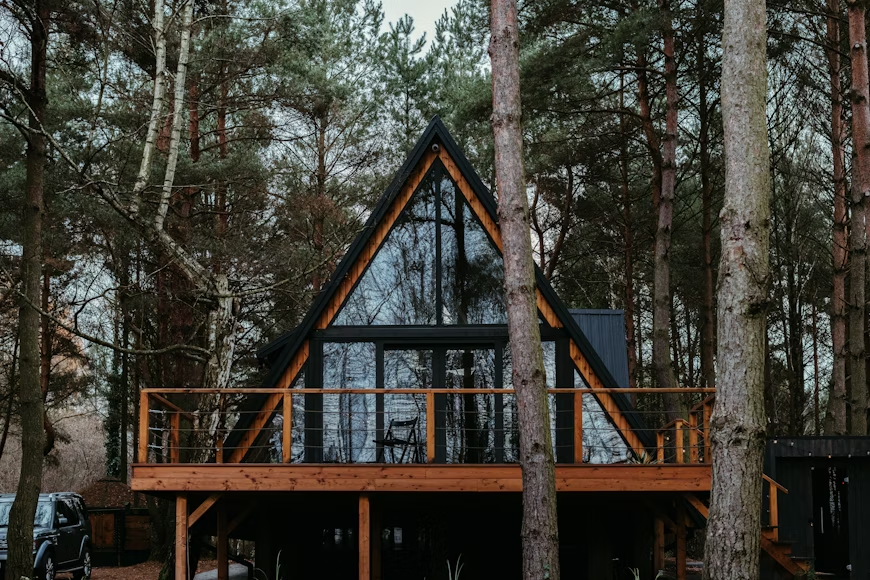Beauty can be found in the things we don’t often see. It’s in a candy floss sunset or a pinch of dew on a mountain flower.
And then there’s beauty in the things we create. Expertly crafted with love and passion. When you’re building something meant to be adored, that’s true mastery. Some might argue it’s a dying art. And that’s why preserving its purity is of utmost importance.
Timber, for example, is a simple piece of wood. But look closer. Every grain tells a story. The joints reveal secrets of centuries past. Every frame, a heartbeat carried forward, because timber frame craftsmanship is as much about soul as it is about skill.
The Living Legacy of Timber Frames
In the heart of British Columbia is the Kootenay region. Surrounded by mountainous forest and wooded areas, the residents take pride in their heritage.
Nelson, in particular, is known for its unique timber frame homes, and keeping that tradition alive involves regular upkeep. According to Hamill Creek Timber Homes, artisans in the area are dedicated to the tradition of crafting beautiful timber homes. They are the backbone of barns and gathering places that hold communities together.
The rest of the continent is experiencing a timber frame farmhouse revival. Across the U.S. and Canada, projects celebrate history while breathing new life into salvaged wood.
That’s the beauty of these initiatives. Locals aren’t preserving lumber; they’re safeguarding the human stories etched into it.
Building for Centuries, Not Seasons
Fast builds and quick fixes dominate the world today. True timber craftsmanship isn’t about shortcuts.
Timber enthusiasts argue that timber framing is conservation in action. It’s about constructing with integrity, using natural materials, and the kind of care that means your grandchildren will be walking those floors.
Timber preservation is a quiet rebellion against the disposable culture. When you mortise and tenon a joint, you’re making a promise: this frame will hold through storms, through winters, through centuries.
Craftsmanship That Tells Stories
Conservancy is storytelling. In Ohio, the Barn Tour collects the histories tied to each timber, each beam shaped by hand.
Walking through those barns, you can almost hear the echoes of farmhands, families, and festivals. Saving a barn is saving a chapter of American life.
It’s the same spirit that drives the Avon Hills Folk School, where conservation meets education. Craftsmen and women pass on their skills because what good is knowledge if it dies with us?
Preserving wood is also about preserving wisdom.
Innovation Meets Tradition
Tradition and innovation don’t have to clash. They can dance together.
The new XBAMBOO cabin in China shows how students reimagine timber frames with bamboo and AI design, proving that old methods can inspire futuristic creations.
Even at global scales, the philosophy holds. The Gelephu International Airport in Bhutan is a fusion of craftsmanship and architecture, where timber meets modern engineering.
This is the lesson: timber preservation is not about freezing time. It’s about adapting skillfully while holding onto the essence of what makes wood work so human.
More Than Buildings
Across the world, timber craft carries culture forward. In Asia, the traditional wooden boat crafting center rejuvenates the artistry of wooden boats.
The center keeps vessels afloat, but it also keeps communities connected to their identity, their heritage, and the waters that shaped them.
That’s a reminder: craftsmanship is culture. And culture is worth protecting.
Why Now?
Why does all this matter in 2025? Because we’re living in an age of shortcuts. Prefab, mass-produced, replaceable. We throw away as easily as we build.
Timber preservation asks us to slow down. To build for permanence, not profit.
And here’s the kicker: it’s sustainable. Preserving and repurposing wood is conservation.
It reduces waste, respects forests, and honors the resources we already have. Every preserved frame is a vote for a future where building means belonging, not consuming.
The Craftsmen’s Pride
There’s nothing like the satisfaction of fitting a joint by hand and knowing it will outlast you.
When you step back and look at a finished frame, you don’t see wood. You see resilience. Patience. Care. And love. This work humbles you. Wood cracks. Tools slip. Yet, with each challenge comes mastery.
When you see people gathering in a hall you restored, or children running through a barn you saved, you understand: this is legacy.
You can argue that preserving timber craftsmanship is nostalgia. It also gets to the heart of writing the next chapter with skill and passion. From barns in Ohio to boats in Asia, timber preservation is alive. It’s evolving. And it’s worth fighting for.
That’s as good a reason as any to keep the art of timber frame preservation active.

